LETTERS TO THE EDITOR.
CHURCH ELRENICA. [To THE EDITOR Or THE "SPECTATOR."] SIR,—Like you, I am puzzled by the letter which appears in the Spectator of January 18th, with the signatures of my friends the Dean of Peterborough and Mr. Teignmouth Shore. Like you, I wait for the public meeting of "Churchmen in Council" to see how far the two voices, which have hitherto seemed discordant, are brought into harmony.
On two points only in your criticism on my letter I will ask leave to say a very few words :-
(1.) If wishes could be father to my thoughts, I should welcome the most infinitesimal scintilla of evidence that the Ornaments' Rubric was framed on the principle of elasticity.
But I have never met with any fragment of such evidence Can it lie in the wording of the rubric, which says : "Shall be retained and be in use " ? Can it be found in the Act of Uniformity, which says in its preamble : "Nothing
conduceth more to the settling of the peace of this nation nor to the honour of our religion than an universal agreement in the public worship of Almighty God ;" and, again, in the "black Bartholomew" clause, "to the end that uniformity in the public worship of God (which is so much desired) may be speedily effected." Is it to be found in any recorded utterances in Parliament during the progress of the Act, or in any contemporaneous exposition after it was passed, or in any judicial decision since ? Till these questions are answered, I fear I must adhere to my conclusion that the Ornaments' Rubric is tight "red-tape," and not an "elastic band."
(.a.) Would an Act of Parliament embodying what we thought was the Dean of Peterborough's plan be possible, without schedules of maxima or minima ? Already leading members of the so-called Ritualist party (if I remember rightly, Mr. Berdmore Compton, in the Church Times) declare that they refuse to be tied up to the rubrics of the Prayer- Book of 1549, and claim the right, in interpreting the "Magna Charta " of their freedom, to roam at will among all the "ornaments of the Church and the ministers thereof, as were in use, by the authority of Parliament, in the second year of King Edward VI. ;" and that opens a rather wide range of possibilities. The Advertisements of Elizabeth ordered the cope to be worn at communion by the celebrant and assistant clergy in all cathedrals. How many "reasonable Evangelicals" are prepared to obey that order P And, after all, the Orna- ments' Rubric does but cover a corner of the field of conflict. Not one of the six points in the Bishop of Lincoln's case is



















































 Previous page
Previous page